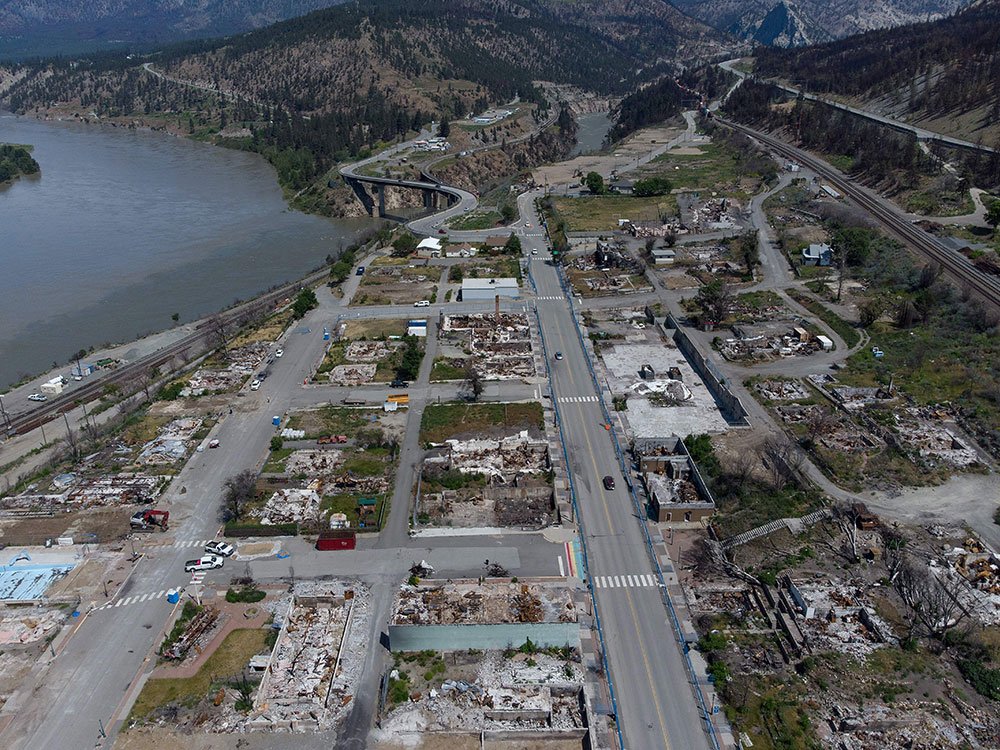The victims of the 2017 Lytton wildfire, which caused extensive damage to their homes, are taking their case to the BC Supreme Court. The lawsuit, which was filed in December of 2019, alleges that BC Hydro was negligent in the maintenance of its power lines, which are believed to be the cause of the fire. The plaintiffs are seeking damages for the losses they suffered, including physical and emotional damages. A court date has not yet been set.
A proposed class action lawsuit, reviewed in BC Supreme Court this week, could seek compensation for residents of the Lytton area and shed light on the cause of the devastating 2021 wildfire.
Announcements, events and more from Tyee and select partners
Find out more about today’s “war on journalists”
David Beers will sound a rescue alert for Canada’s news media in his Southam Lecture at UVic next Tuesday. Here’s a preview.
CONTEST: Win tickets to the local theater for Black History Month
One lucky Tyee reader will receive two tickets to Broken Chord this February.
The fire destroyed 90 percent of the small community and two people were killed.
A hearing is underway in Vancouver to determine whether the court will uphold the class action lawsuit filed in October 2021 by the law firm Slater Vecchio LLP on behalf of Christopher O’Connor, Jordan Spinks and everyone affected by the Lytton Creek wildfire.
If the case is approved, the plaintiffs will ask the BC Wildfire Service, which is responsible for determining the cause of the fire, to release information about what led to the fire, which it has not done in the 19 months since the fire.
The proposed lawsuit seeks damages from Canadian Pacific and Canadian National Railways, the Canadian government and a US-based rail safety company operating as eRailSafe Canada.
Despite widespread speculation that a train started the fire, an official cause has never been released.
In October 2021, an investigation by the Transportation Safety Board of Canada said it found “no evidence” the fire was caused by the railroad.
The railway companies also rejected responsibility.
But Lytton residents have criticized the TSB inquiry, saying only railway employees – and not local people who witnessed the outbreak of the fire – were interviewed.
Lead plaintiffs O’Connor and Spinks, both Lytton area residents, allege that negligence on the part of Canada’s leading railroad companies and the federal government created conditions leading to the Lytton Creek wildfire that a filing said were “foreseeable and avoidable.” filed in December, asking the courts to uphold the class action lawsuit.
“Plaintiffs allege that defendants CN Rail and CP Rail, who owned, occupied and/or maintained and controlled the land on which the Lytton Creek wildfire broke out, knew or should have known that the area posed a serious risk of wildfires in the summer,” says the application.
“They had a duty to take fire safety measures and they failed to take reasonable steps or any steps to prevent the Lytton Creek wildfire.” Several unnamed defendants in the lawsuit are said to be responsible for things like manufacturing trains and railroad tracks, fire safety and monitoring conditions, the motion said.
None of the allegations were tested in court.
Spinks is the former Chief of Lytton First Nation and O’Conner is the former Mayor of Lytton.
The Lytton Creek fire was started on June 30, 2021, south of Lytton, a village of about 250 people, when the province was in a deadly heat dome.
In early June 2021, the BC Wildfire Service issued a monthly bulletin noting that many regions in the province had received little rainfall and that 284 wildfires had been spotted since April, the most recent application said. The service predicted that “the frequency and size of fires will increase as the hot dry spell continues,” he adds.
The bulletin was followed by heat warnings from Environment Canada with temperatures of 40C or more in the Lytton area. The village would break heat records for three consecutive days in late June, reaching 49.6 degrees Celsius on June 29 – the highest temperature ever recorded in Canada.
According to the application, fire broke out “on or near” the railway tracks near the south end of Lytton the following afternoon, around the time a train of 157 coal wagons passed through Lytton. The train was owned by CP Rail and operated by CN Rail.
As it passed, a forward-facing camera on the train showed “no evidence of a fire” where the fire is believed to have started, court records said. But “shortly after” the train passed through the area, the first wildfire calls were received by the emergency services, according to the application.
Eyewitnesses, including Spinks, “observed smoke and flames at or near the CNR Fraser Bridge when the fire broke out,” it said.
A year on from the Lytton fire, residents are awaiting answers and action
Continue reading
“The wildfire at Lytton Creek moved rapidly north toward Lytton, resulting in an evacuation order and the near-total destruction of the village,” the filing reads. The fire also devastated nearby First Nations reservations, destroying homes, businesses, a church, Nlaka’pamux Health Services, a daycare center and the Lytton First Nation band office.
“The Lytton Creek wildfire burned over 85,020 acres of land resulting in two deaths and widespread destruction,” the filing reads. It would take two months to bring the wildfire under control.
The lawsuit alleges that CN Rail and CP Rail, which operate in the Lytton area and share the track, “failed to minimize fire risk in fire-prone areas of British Columbia, including Lytton,” prior to the fire. by failing to ensure the area was cleared of organic material and other sources of fuel and failing to ensure that train operations were unlikely to start a fire.
The companies also failed to maintain or deploy firefighting or prevention equipment, failed to implement or comply with wildfire prevention guidelines, and failed to ensure personnel were trained to minimize fire risk, the filing said.
Last summer, a year after the fire, The Tyee contacted the BC Wildfire Service and RCMP for an update on their joint investigation.
At the time, the Forest Fire Service said it was “actively” working with the force on the investigation, focusing on determining the origin and cause of the fire. It suggested that a report could be made available by autumn.
When asked again in December, the wildfire service said it had no news on the investigation and could not give a timeline for releasing the report. It said its website will be updated as information becomes available.
As of Tuesday, the cause of the Lytton Creek fire remained “undetermined.”
The Tyee also requested an update from the RCMP this week. Sergeant Kris Clark, senior media relations officer at the BC RCMP, said in an email: “The investigation remains active and ongoing, but there are no updates that we can provide at this time.”
Although investigation reports into BC’s wildfires are not routinely released, The Tyee has reviewed more than a dozen Freedom of Information reports released over the past decade.
They show that in most cases the fieldwork to determine the cause of the fire is completed within a few days of the fire starting. The reports, which often ran to hundreds of pages, were all published within a year, with the average time it took for the results to be published around six months.
If the O’Connor-Spinks lawsuit goes ahead, plaintiffs are seeking prompt disclosure of documents by defendants.
However, Sam Jaworski, a litigator at Slater Vecchio LLP, confirmed that certification does not automatically compel the wildfire service to provide the records.
The documents sought include the fire investigators’ reports, as well as supporting data such as photos, videos, witness interviews and “the identification of possible categories of fire causes.”
Also required are railway company timetables, safety management systems, risk assessments, maintenance records, fire safety plans, training records, and plans related to fire hazard and extreme weather risk, the plaintiffs’ motion states.
They are seeking relief for “common law damages for negligence and harassment, related healthcare costs, punitive damages, and declaratory and injunctive relief.”
The hearing is expected to last until Friday. It is not known when the court will make a decision.
Don’t miss interesting posts on Famousbio









